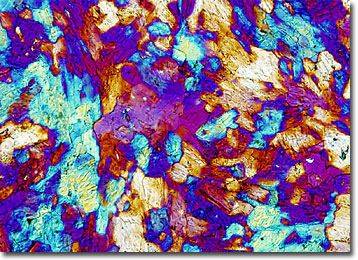Polarized Light Microscopy Digital Image Gallery
Gypsum
Composed of calcium sulfate, gypsum is a widespread mineral of significant commercial value. Among the greatest producers of gypsum are the United States, Great Britain, Canada, and France.

Gypsum can be found around the world in a variety of forms and is often known by different names based upon its appearance. When it occurs as clear, well-developed crystals, gypsum is commonly referred to as selenite. However, the fibrous form of the mineral, which has a characteristic luster, is known as satin spar. It is this form of gypsum that finds use in a wide variety of jewelry and ornamental work. Massive deposits of fine-grained gypsum, on the other hand, are most commonly called alabaster, a material frequently utilized to construct statues.
In addition to its more aesthetic and ornamental uses, gypsum commonly finds practical use as a key component of many plasters. In fact, gypsum is the central agent found in the widely known plaster of paris, which has been utilized since antiquity. A fine white powder, plaster of paris is created by expelling the water from gypsum through exposure to heat. The material, which sets quickly, is frequently used in the medical field to construct casts, but is perhaps even more commonly used as a building material.
